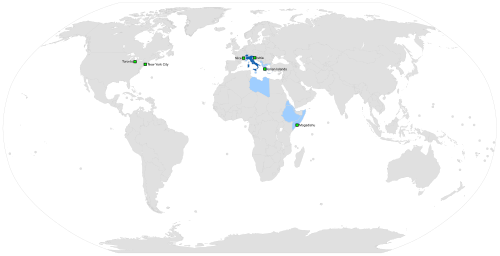
Back Аиталиа бызшәа Abkhazian Italiaans Afrikaans Italienische Sprache ALS ጣልያንኛ Amharic Italisc sprǣc ANG इतालवी भाषा ANP اللغة الإيطالية Arabic ܠܫܢܐ ܐܝܛܠܝܐ ARC طاليانية ARY لغه طليانى ARZ
| Iste articlo ye en proceso de cambio enta la ortografía oficial de Biquipedia (la Ortografía de l'aragonés de l'Academia Aragonesa d'a Luenga). Puez aduyar a completar este proceso revisando l'articlo, fendo-ie los cambios ortograficos necesarios y sacando dimpués ista plantilla. |
| Italiano | ||
|---|---|---|
| Atras denominacions: | {{{atrasdenominacions}}} | |
| Parlau en: | Italia, Suiza y atros 28 países. | |
| Rechión: | Europa meridional. | |
| Etnia: | Italianos | |
| Parladors: | 70 millons | |
| Posición: | {{{clasificación}}} (Ethnologue 1996) | |
| Filiación chenetica: | Indoeuropea Italicas |
|
Estatus oficial
| ||
| Oficial en: | ||
| Luenga propia de: | {{{propia}}} | |
| Reconoixiu en: | {{{reconoixiu}}} | |
| Regulau por: | Accademia della Crusca | |
Codigos
| ||
| ISO 639-1 | it | |
| ISO 639-2 | ita | |
| ISO 639-3 | {{{iso3}}} | |
| SIL | ita | |
 Extensión d'o Italiano
| ||
L'italiano[1] ( u lingua italiana) ye una luenga romance.[2] Ye a segunda mas amanada a o latín en termins de vocabulario dimpués d'o sardo.[3][4] L'italiano ye una luenga oficial en Italia, Suiza, San Marino, a Ciudat d'o Vaticano, y Istria (en Eslovenia y Croacia). Tenió en o pasau estatus oficial en Albania, Malta y Monaco, a on encara ye prou estendillada, asinas como en as antigas colonias de Africa Oriental italiana y Africa Septentrional italiana a on encara chuga un papel important en bels sectors. L'italiano ye charrau por una gran comunidat d'expatriaus en America y minorías en atros puestos como Crimea, Francia (mas que mas en Corcega), Belchica, Montenegro y Tunisia.[5] Muitos fablants nativos son bilingües, charrando tanto l'italiano estándard como beluna d'as otras luengas rechionals.[6]
A luenga italiana moderna se basa en o dialecto toscano de Florencia, Pisa y Siena debiu a que en iste dialecto s'escribió A Divina Comedia, a primera obra literaria escrita en "luenga moderna". O toscano ye a luenga en a que escribioron Dante Alighieri, Petrarca y Boccaccio, os tres grandes escritors d'o Renaiximiento italiano.
- ↑ (an) Diccionario aragonés-castellano-catalán. Estudio de Filología Aragonesa. Edacar num. 14. Zaragoza. Edicions Dichitals de l'Academia de l'Aragonés. ISSN 1988-8139. Octubre de 2024.
- ↑ Simone, 2010
- ↑ See Italica 1950: 46 (cf. [1] and [2]): “Pei, Mario A. "A New Methodology for Romance Classification." Word, v, 2 (Aug. 1949), 135–146. Demonstrates a comparative statistical method for determining the extent of change from the Latin for the free and checked accented vowels of French, Spanish, Italian, Portuguese, Rumanian, Old Provençal, and Logudorese Sardinian. By assigning 3½ change points per vowel (with 2 points for diphthongization, 1 point for modification in vowel quantity, ½ point for changes due to nasalization, palatalization or umlaut, and −½ point for failure to effect a normal change), there is a maximum of 77 change points for free and checked stressed vowel sounds (11×2×3½=77). According to this system (illustrated by seven charts at the end of the article), the percentage of change is greatest in French (44%) and least in Italian (12%) and Sardinian (8%). Prof. Pei suggests that this statistical method be extended not only to all other phonological, but also to all morphological and syntactical, phenomena.”
- ↑ See Koutna et al. (1990: 294): “In the late forties and in the fifties some new proposals for classification of the Romance languages appeared. A statistical method attempting to evaluate the evidence quantitatively was developed in order to provide not only a classification but at the same time a measure of the divergence among the languages. The earliest attempt was made in 1949 by Mario Pei (1901–1978), who measured the divergence of seven modern Romance languages from Classical Latin, taking as his criterion the evolution of stressed vowels. Pei's results do not show the degree of contemporary divergence among the languages from each other but only the divergence of each one from Classical Latin. The closest language turned out to be Sardinian with 8% of change. Then followed Italian — 12%; Spanish — 20%; Romanian — 23,5%; Provençal — 25%; Portuguese — 31%; French — 44%.”
- ↑ Ethnologue report for language code:ita (Italy) – Gordon, Raymond G., Jr. (ed.), 2005. Ethnologue: Languages of the World, Fifteenth edition. Dallas, Tex.: SIL International. Online version
- ↑ "Italy". Ethnologue. 1999-02-19. http://www.ethnologue.com/show_country.asp?name=IT. Retrieved 2015-10-22.